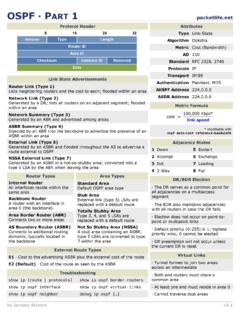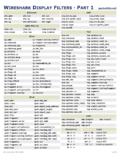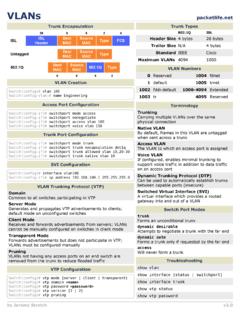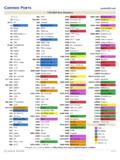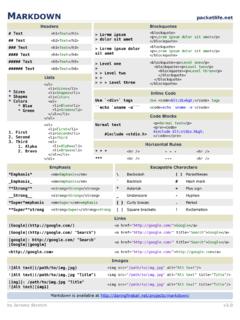Transcription of Visio-Internal Routing Protocols Poster - …
1 Global Routing Protocols ComparisonTypeAlgorithmDistance VectorBellman-FordRIPD istance VectorDUALEIGRPLink StateDijkstraOSPFLink StateDijkstraIS-ISPath VectorPath SelectionBGPA dmin DistanceStandard120 RFCs 2080, 245390/170 (external)/5 (summary)Cisco proprietary110 RFCs 2328, 5340115 ISO 10589, RFC 114220/200 (IBGP)RFC 4271 Supported ProtocolsTransportIPv4, IPv6 UDP/520 IPv4, IPv6, IPX, AppletalkIP/88 IPv4, IPv6IP/89 IPv4, IPv6, CLNPL ayer 2 IPv4, IPv6 TCP/179 AuthenticationPlain, MD5MD5 Plain, MD5, AH (v3)Plain, MD5MD5 RIPM etric Formula bw= 107/ minimum path bandwidth in kbps delay= interface delay in secs / 10!
2 Enable EIGRP for an autonomous system[ipv6] router eigrp AS-number! Specify a router ID formatted in IPv4 dotted-decimal[eigrp] router-id router-ID! Disable automatic classful summarization (IPv4 only)no auto-summary! Enable EIGRP on interfaces by network (IPv4 only)network IPv4-address wildcard-mask! Modify maximum paths for equal-cost load balancingmaximum-paths 1-16! Configure multiplier for unequal-cost load balancingvariance 1-128! Configure K values to manipulate the metric formulametric weights 0 k1 k2 k3 k4 k5! Explicitly identify neighbors on NBMA linksneighbor IP-address interface!
3 Designate passive interfacespassive-interface {interface| default}! Enable stub Routing [eigrp] stub [receive-only | connected | static | summary | redist]Default K ValuesPacket TypesK11K20K31K40K501 Update3 Query4 Reply5 Hello8 AcknowledgeFeasible DistanceThe distance advertised by a neighbor plus the cost to get to that neighborReported DistanceThe metric for a route advertised by a neighborStuck In Active (SIA)The condition when a route becomes unreachable and not all queries for it are answered; adjacencies with unresponsive neighbors are resetPassive InterfaceAn interface which does not participate in EIGRP but whose network is advertisedStub RouterA router which advertises only a subset of routes, and is omitted from the route query processEIGRPT erminologyMulticast ConfigurationInterface Configurationinterface type number!
4 Enable EIGRP for IPv6 on the interfaceipv6 eigrp AS-number! Set the maximum bandwidth EIGRP can consume (can be >100%)ip[v6] bandwidth-percent eigrp AS-number 1-999999! Configure manual summarization of outbound routesip summary-address eigrp AS-number IPv4-address subnet-mask[AD]ipv6 summary-address eigrp AS-number IPv6-prefix[AD]! Enable MD5 authenticationip[v6] authentication mode eigrp AS-numbermd5ip[v6] authentication key-chain eigrp AS-number key-chain! Modify interface hello and hold timersip[v6] hello-interval eigrp AS-number secondsip[v6] hold-time eigrp AS-number seconds! Toggle split horizon[no] ip[v6] split-horizon eigrp AS-numberTroubleshootingshow ip[v6] eigrp {interfaces | neighbors }show ip[v6] eigrp topologyclear ip[v6] eigrp [AS-number] neighborsdebug ip[v6] eigrp [neighbor]Default TimersHello5 secHold15 secLAN (>T1)60 sec180 secWAN (<=T1)256 * (K1* bw+ + K3* delay) * K2* bw256 -loadK5rel+ K4 Router RolesInternal RouterAll interfaces reside within the same areaBackbone RouterA router with at least one interface in area 0 Area Border Router (ABR)Connects two or more areasAS Boundary Router (ASBR)
5 Connects to additional Routing domains (redistribution to or from other Protocols )Troubleshootingshow ip[v6] ospf [process] interfaceshow ip[v6] ospf database [LSA-type]OSPFv2 Link State AdvertisementsRouter Link (Type 1)Lists neighboring routers and the cost to each; flooded within an areaNetwork Link (Type 2)Generated by a DR; lists all routers on an adjacent segment; flooded within an areaNetwork Summary (Type 3)Generated by an ABR; advertises routes between areasASBR Summary (Type 4)Injected by an ABR into the backbone to advertise the presence of an ASBR in a non-backbone areaExternal Link (Type 5)Generated by an ASBR and flooded throughout the AS to advertise a route external to OSPFNSSA External Link (Type 7)Generated by an ASBR in a not-so-stubby area.
6 Converted into a type 5 LSA by the ABR when leaving the areaArea TypesStandard AreaDefault OSPF area typeStub AreaExternal link (type 5) LSAs are replaced with a single default routeTotally Stubby AreaType 3, 4, and 5 LSAs are replaced with a default routeNot-So-Stubby Area (NSSA)A stub area containing an ASBR; type 5 LSAs are converted to type 7 within the areaExternal Route TypesE1 Considers the cost to the advertising ASBR plus the external cost of the routeE2 (Default)The external cost of a route as seen by the ASBR; internal OSPF cost is not consideredshow ip[v6] ospf border-routersshow ip[v6] ospf virtual-linksdebug ip[v6] ospf [.]
7 ]Metric FormulaDR/BDR Election The BDR also maintains adjacencies with all routers in case the DR fails Does not occur on point-to-point or multipoint links Default priority (0-255) is 1; highest priority wins; 0 cannot be elected DR preemption will not occur unless the current DR is resetVirtual Links Tunnel formed to join two areas across an intermediate Both end routers must share a common non-stub area At least one end must reside in area 0 Adjacency States12 DownAttempt56 ExStartExchange34 Init2-Way78 LoadingFull The DR serves as a common point for all adjacencies on a multiaccess segmentNetwork TypesDR/BDR ElectedNonbroadcast (NBMA)
8 Multipoint BroadcastNeighbor DiscoveryHello/Dead TimersDefined BySupported TopologyMultipoint NonbroadcastBroadcastPoint-to-PointYesNo 30/120 RFC 2328 Full MeshNoYes30/120 RFC 2328 AnyNoNo30/120 CiscoAnyYesYes10/40 CiscoFull MeshNoYes10/40 CiscoPoint-to-PointOSPFI ntegrated IS-ISNetwork TypesDIS ElectedYesBroadcastNeighbor DiscoveryYesHello/Dead Timers10/30 Adjacency Requirements Interface MTUs must match Areas must match (if level 1) System IDs must be unique Authentication must succeedshow [clns | isis] neighborsshow clns interfaceshow isis [ipv6] topology Levels must matchNSAP AddressingInterdomain Part (IDP)Portion of the address used in Routing between autonomous systems; assigned by ISOD omain-Specific Part (DSP)Portion of the address relevant only within the local ASAuthority and Format Identifier (AFI)Identifies the authority which dictates the format of the addressInitial Domain Identifier (IDI)An organization belonging to the AFIHigh Order DSP (HODSP)The area within the ASSystem IDUnique router identifier.
9 48 bits for Cisco devices (often taken from an Ethernet MAC address)NSAP Selector (SEL)Identifies a network layer service; always 0x00 in a NETNoPoint-to-PointYes10/30 Troubleshootingshow isis [database | spf-log]debug [clns | isis] [..]ISO Routing LevelsLevel 0 Level 1 Level 2 Used to locate end systemsRouting within an area (IS-IS) Routing between areas (IS-IS)Level 3 Inter-AS routingTerminologyType-Length-Value (TLV)Variable-length modular datasets carried by PDUsLink State PDU (LSP)Carry TLVs encompassing link state informationDIS Election Highest-priority interface elected Highest system ID breaks SNPA tie Default interface priority is 64 Current DIS may be preempted, unlike OSPF Highest SNPA ( MAC or DLCI) breaks tieSequence Number Packet (SNP)Used to request and advertise LSPs.
10 Can be complete (CSNP) or partial (PSNP)Network Entity Title (NET)Unique router ID; includes area IDDesignated Intermediate System (DIS)A pseudonode responsible for emulating point-to-point links across a multi-access segmentGlobal Configuration! Create an OSPF process[ipv6] router ospf process-ID! Specify a router ID formatted as IPv4 dotted-decimalrouter-id router-ID! Modify the default reference bandwidthauto-cost reference-bandwidth speed-in-mbps! Assign interfaces to areas by network (OSPFv2)network IPv4-address wildcard-maskarea area! Identify neighbors for NBMA links (OSPFv2)neighbor IPv4-address[cost 1-65535]!


